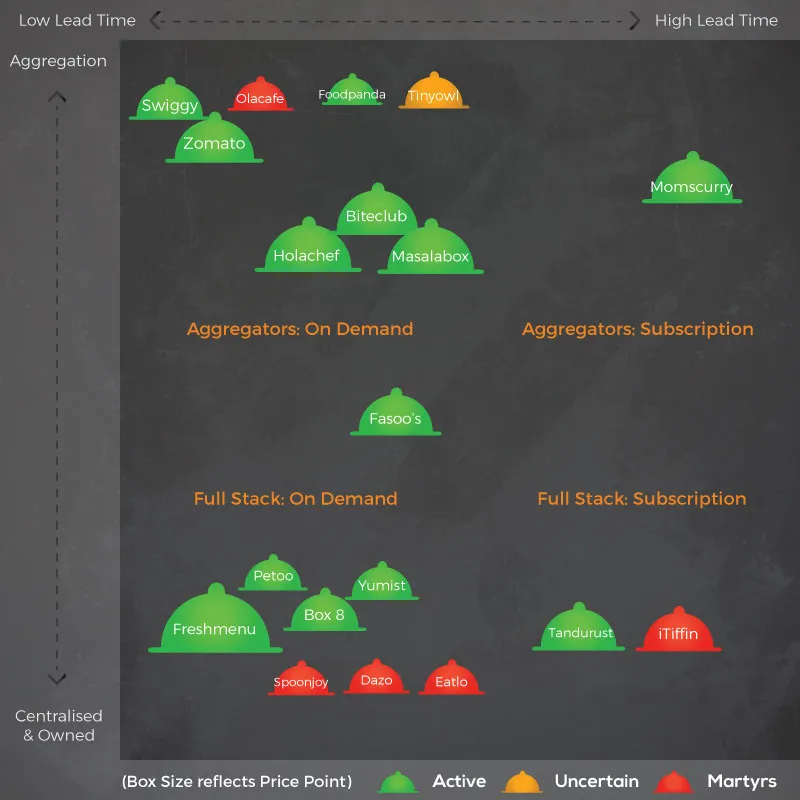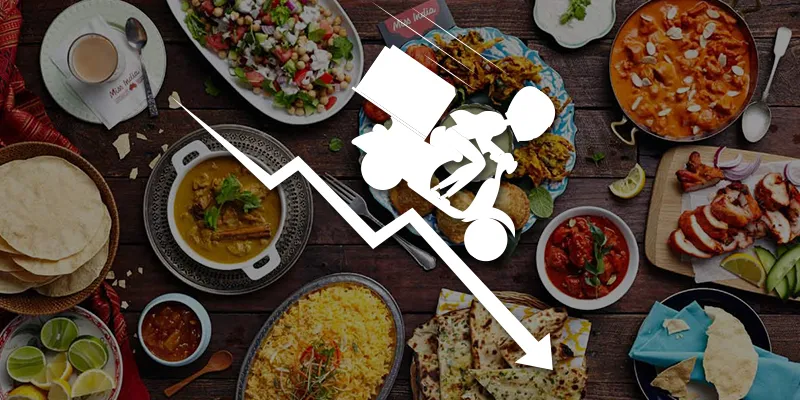An entrepreneur’s perspective on what is ‘broken’ in foodtech
In 2015, Indian VCs were salivating over foodtech startups, and we saw multiple startups raise huge rounds of funding. Fast forward to 2016, and some have died out, some are hanging in there, and others have pivoted or been acquired. VCs now seem to have developed ‘indigestion’ and an aversion for the whole sector. I don’t think any other sector has seen such a rapid rise and fall. Here is how foodtech in India stands now:
The sector has witnessed a mix of aggregators, full stack service providers, and Internet-first kitchens.
Casualties (Martyrs) - Spoonjoy, Eatlo, Chefensa, iTiffin, Dazo, Langar, and Olacafe.
Standing tall (at least till now) - Yumist, Mealboat, Masalabox, Tandurust, Biteclub, and Holachef.
The Sharks - Freshmenu, Swiggy, Foodpanda, and Zomato.

Related read from October 2015: Is this the end of the honeymoon period for foodtech startups
Only a few have survived and the going has not been smooth for them. I founded a foodtech startup myself – Momscurry – and have now exited the company (my partner still runs the startup and I wish him all the best) after getting a first-hand taste of the major hurdles that entrepreneurs have to go through.
Delivery
Foodtech started with a few basic assumptions - hyperlocal delivery is cheap, reliable, and quick. But time has proved this false. I have spoken (and experienced in my own startup too) to multiple delivery people from Swiggy, Roadrunnr, Opinio and on a particular weekday they do somewhere about 8-12 deliveries in a day considering 10 hours shift and 45 mins time per delivery. Why 45 minutes per delivery? Because they have to find both restaurant and customer in strange Indian topography.
Also, most delivery boys from well-known hyperlocal companies (HLDC) call customers every time to ask for directions as they are mostly forced into the job due to its lucrative nature, but have no real sense of directions or etiquette to talk. They get paid an average of Rs 20,000-25,000 per month or Rs 45-100 per delivery.
On several occasions, our team witnessed that they don't carry delivery bags but hook the food up to the handlebar, which is highly unsafe, unhygienic, and unreliable. It is difficult to control a huge force of blue-collared workers when your dependency on them is so high. I found top management (of HLDC) talking helplessly and apologising to us on their behalf.
So you are delivering food using an extremely unreliable force in 45 minutes after spending Rs 75 (on average). Secondly, lunch time is typically between 12 noon -2 pm and dinner between 7 pm – 9 pm. At 1.15 pm, order booking generally show 500 orders to be delivered. However, at 3.30pm, it shows not even five have not been completed. The ‘30 minutes or free’ guarantees have changed customer expectations and so startups have to deploy extra manpower to deliver food or else fail on service.
The food itself
In an interview to the Times of India K Ganesh of Freshmenu said, “While the barriers are low, it is a tough business as people's opinions are whimsical. In food, people get bored easily even if it is good.”
This a herculean problem to solve. Customer loyalty to a particular brand is very low. Moreover, food involves human effort, which tends to be heterogeneous over a period of time. This is the story of most of full-stack service providers as they don't know how to retain a customer after say 3,5,10 successful orders. An aggregator like us has to work hard to maintain uniformity in service as food comes from multiple places where you don't have much control. If one of your restaurants or chefs has a bad day and delivers sub-par food, your brand takes the hit.
Now, does that mean no food business can survive for long? In a study in the US, they found 85 percent of all restaurants pack up in less than an year. So the one that have survived either come with deep pockets and a well-researched product (McD, Dominos, etc.) or they sell commoditised food items (Sagar Chains, Aggarwal Bhavan, etc.) at competitive prices.
So, it will be difficult for any company in foodtech to survive if they don't come up with something as strong as a Dominos Pizza or McD’s Burger.
The misconception entrepreneurs developed was technology will sell the food. What we forgot was it is food which will sell, technology can only make selling better.
Scalability and short shelf life
Another problem with food is short shelf life and if it is mass-produced, it is even shorter. BOX8 fell into a controversy recently when food supplied by them spoiled and children in Mumbai fell sick. The company’s stance was that the food was not consumed within the correct timeframe, whereas organisers say food was stale. FDA slapped a notice on BOX8 for the bad state of their kitchen and food. Now, who is to be blamed?
BOX8 and other such service providers cook food well in advance and then store it in hot van/deep freeze, and when an order is placed, they deliver the same food. Now this process is fine when you are serving a few plates, but in the case of BOX8, it was over 5,000 plates that they delivered on that ill-fated day.
It is very difficult to maintain standard food quality in bulk-produced food.
Indian customers and price sensitivity
Foodtech companies are dealing in a market where you get tea for Rs 10, idly for Rs 15 and a complete thaali meal for Rs 50. When we talk about exotic food, it also comes with an experience. So expensive food is always enjoyed in an elegant restaurant with a great complementary ambience.
You can sell a plate of dal for Rs 600 in an elegant 5 star restaurant, but you can’t charge that while doing home delivery.
We were selling three rotis with dal and sabji for Rs 75, and it was not feasible to sell at that price. So we increased price to Rs 90 and we saw customers abandoning us. We thought we were doing a great service by serving high-quality home food prepared from the best ingredients by tried and tested home chefs.
Even a 10 percent increase in price can see the mass exodus. That is why McD still has an Aloo Tikki Burger and Pizza Mcpuff starting at Rs 20 (or Rs 25) or CCD a coffee and a samosa for Rs 50. They make money through the cross sale of french fries and beverages.
A lot of foodtech companies are trying the same cross-sales technique to increase AOV (average order value). However, you don't get to smell the aroma or see the actual product on a five-inch mobile screen, which could have led to cross sales.
Availability of cooks and maids
All my friends in Bangalore have cooks and maid at their homes. Cooks are available for anywhere between Rs 2,000-5,000 a month and maids for 1,000-3,000 a month. So it is easy to cook food at home and have a healthy meal. Moreover, the younger generation is becoming more health conscious day by day. So ordering food from outside is only if there is no other option left. For companies like us, who served home-made food, the total cost factor plays spoilsport.
We’ve lost multiple customers to home-cooks and maids as the customer perceives the latter as a cheaper and more convenient option.
Every foodtech company wants to increase the number of meals consumed by a customer per week/month. Maids and cooks may not be directly affecting foodtech but in a longer run, it plays a major role in pushing away a customer from ordering food. Indians still don't value service and expect it to come free with the product. So, in presence of cheap labor, it will be difficult for foodtech companies to show the real value they are creating for customers.
Unit Economics

Swiggy, which claims Rs 375 AOV takes 25 percent as their commission from restaurants , saves Rs 19 as gross margin(after deducting a delivery fee of Rs 75). Now the cost of acquisition per customer is anywhere between Rs 150-200 (conservative estimate).
This means the customer must order at least 7-8 times for you to recover CAC. Add other overheads, plus the herculean operational challenge to deliver good, tasty food on time.
Add to that the heavy engineering costs, vendor acquisition cost, and other overheads – companies bleed so fast. Infoedge, the largest investor in Zomato reported a loss of Rs 492 crore on their investment in the latter. Zomato claimed they operationally broke even in six geographies in February 2016. If that is to be believed, then their record losses speak of how hard they are taking hits with delivery.
Related read: Foodtech startups – the one big thing that everyone seems to be missing
Foodtech is struggling globally
It is not just in India; foodtech is yet to produce a poster boy to be followed globally. Even in developed countries like the US, the UK, or other European countries, there isn’t one foodtech company that has proved its business model and which can now be called a success. Munchery in the US is experimenting with its revenue model to ensure longevity.
The on-demand model is suffering everywhere, and companies are looking for more and more unique subscription models. Companies like Blue Apron, HelloFresh, and Plated are in the meal kit service through subscription, but are overwhelmed by competition, despite having deep pockets. So, this sector is yet to mature globally.
So am I saying Foodtech is destined to fail? Based on my experience, both Yes and No. Companies that have started in the last one-three years will find it very difficult to survive as the Indian market has not matured enough to understand foodtech. However, similar business model with a fair amount of innovation and learnings from past failures should be a success 5-10 years down the line.
The younger generation does not like cooking, and they will have to depend more and more on outside food for such services. So entrepreneurs trying to enter the foodtech space should enter it for the long haul as it is difficult to make a quick buck and exit within a short period of time.
(Disclaimer: The views and opinions expressed in this article are those of the author and do not necessarily reflect the views of YourStory)
Related read from March 2016: Global perspective-Swiggy, Ele.Me or Grubhub who will rule the roost







